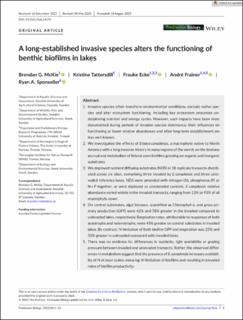A long-established invasive species alters the functioning of benthic biofilms in lakes
Peer reviewed, Journal article
Published version

Åpne
Permanent lenke
https://hdl.handle.net/11250/3096345Utgivelsesdato
2023Metadata
Vis full innførselSamlinger
- Publikasjoner fra CRIStin - NINA [2364]
- Scientific publications [1392]
Sammendrag
1. Invasive species often transform environmental conditions, exclude native spe-cies and alter ecosystem functioning, including key ecosystem processes un-derpinning nutrient and energy cycles. However, such impacts have been most documented during periods of invasive species dominance; their influences on functioning at lower relative abundances and after long-term establishment are less well- known.
2. We investigated the effects of Elodea canadensis, a macrophyte native to North America with a long invasion history in many regions of the world, on the biomass accrual and metabolism of littoral zone biofilms growing on organic and inorganic substrates.
3. We deployed nutrient diffusing substrates (NDS) in 18 replicate transects distrib-uted across six lakes, comprising three invaded by E. canadensis and three unin-vaded reference lakes. NDS were amended with nitrogen (N), phosphorus (P) or N + P together, or were deployed as unamended controls. E. canadensis relative abundance varied widely in the invaded transects, ranging from 13% to 93% of all macrophyte cover.
4. On control substrates, algal biomass, quantified as Chlorophyll-a, and gross pri-mary production (GPP) were 42% and 78% greater in the invaded compared to uninvaded lakes, respectively. Respiration rates, attributable to responses of both autotrophs and heterotrophs, were 45% greater on control substrates in invaded lakes. By contrast, N-limitation of both biofilm GPP and respiration was 25% and 35% greater in uninvaded compared with invaded lakes.
5. There was no evidence for differences in nutrients, light availability or grazing pressure between invaded and uninvaded transects. Rather, the observed differ-ences in metabolism suggest that the presence of E. canadensis increases availabil-ity of N at local scales, reducing N-limitation of biofilms and resulting in elevated rates of biofilm productivity.
6. Our results demonstrate that invasive elodeids might have significant impacts on biofilms and processes associated with the cycling of nutrients, even when long- established and present at lower relative abundances
